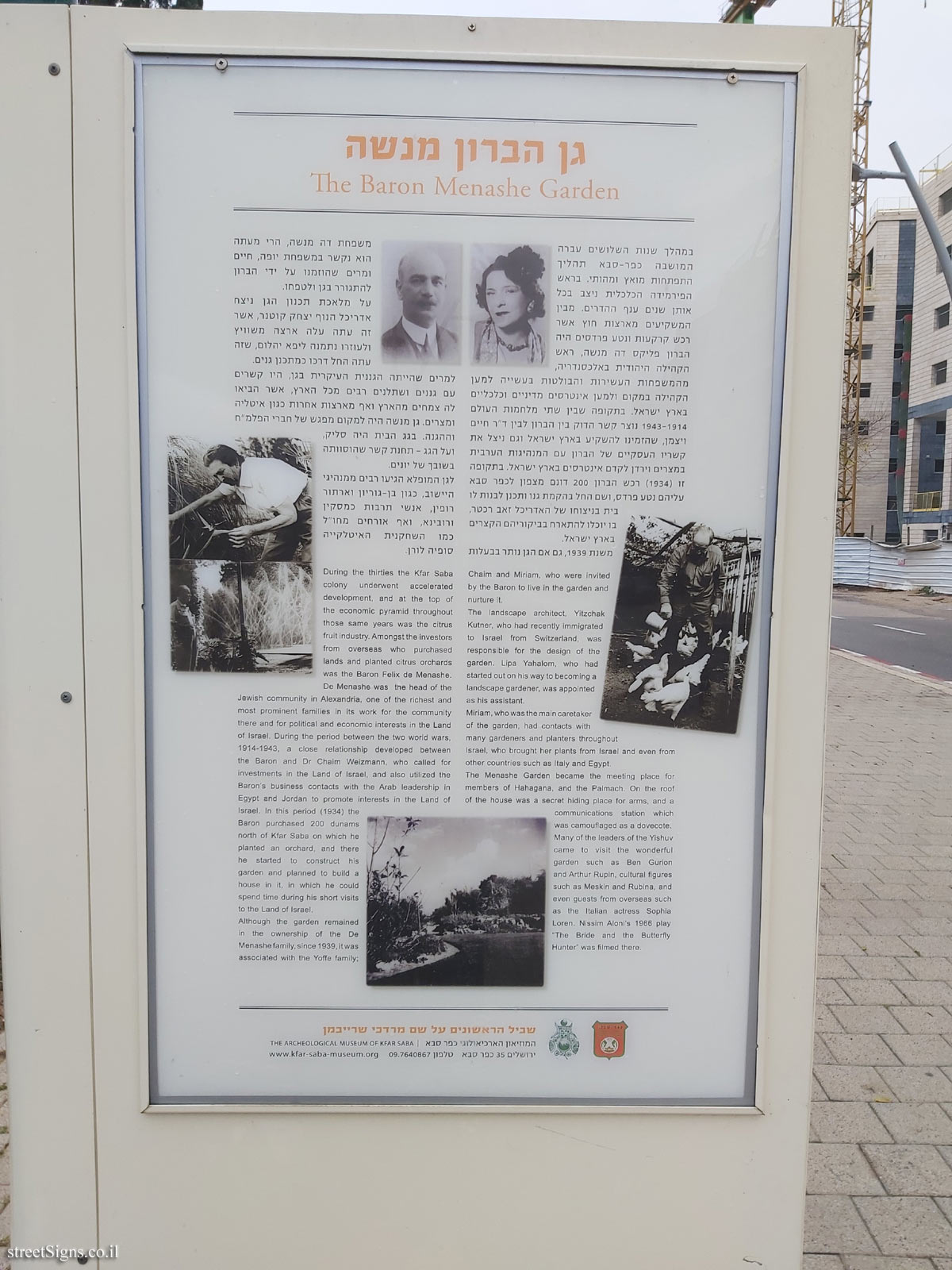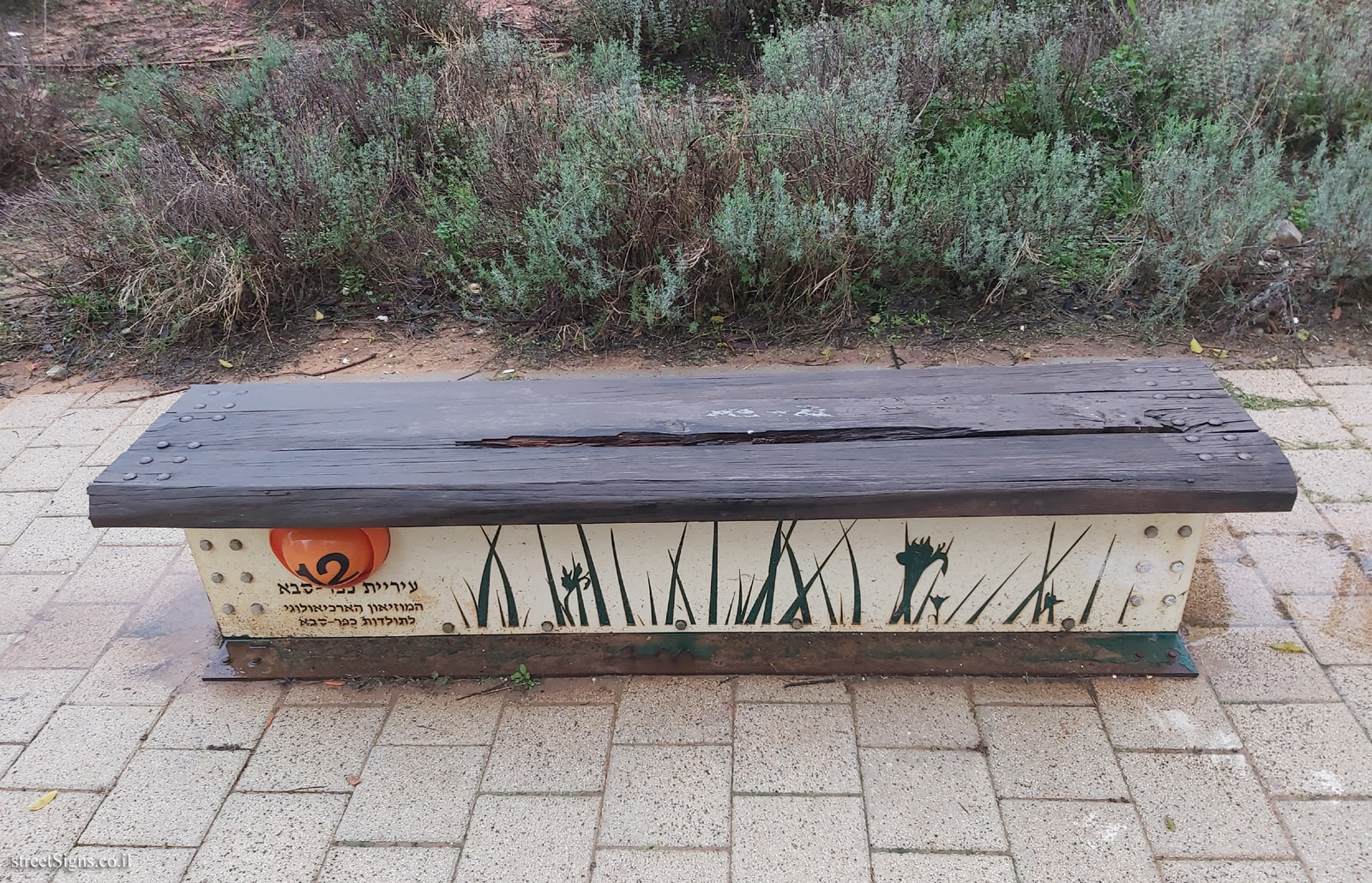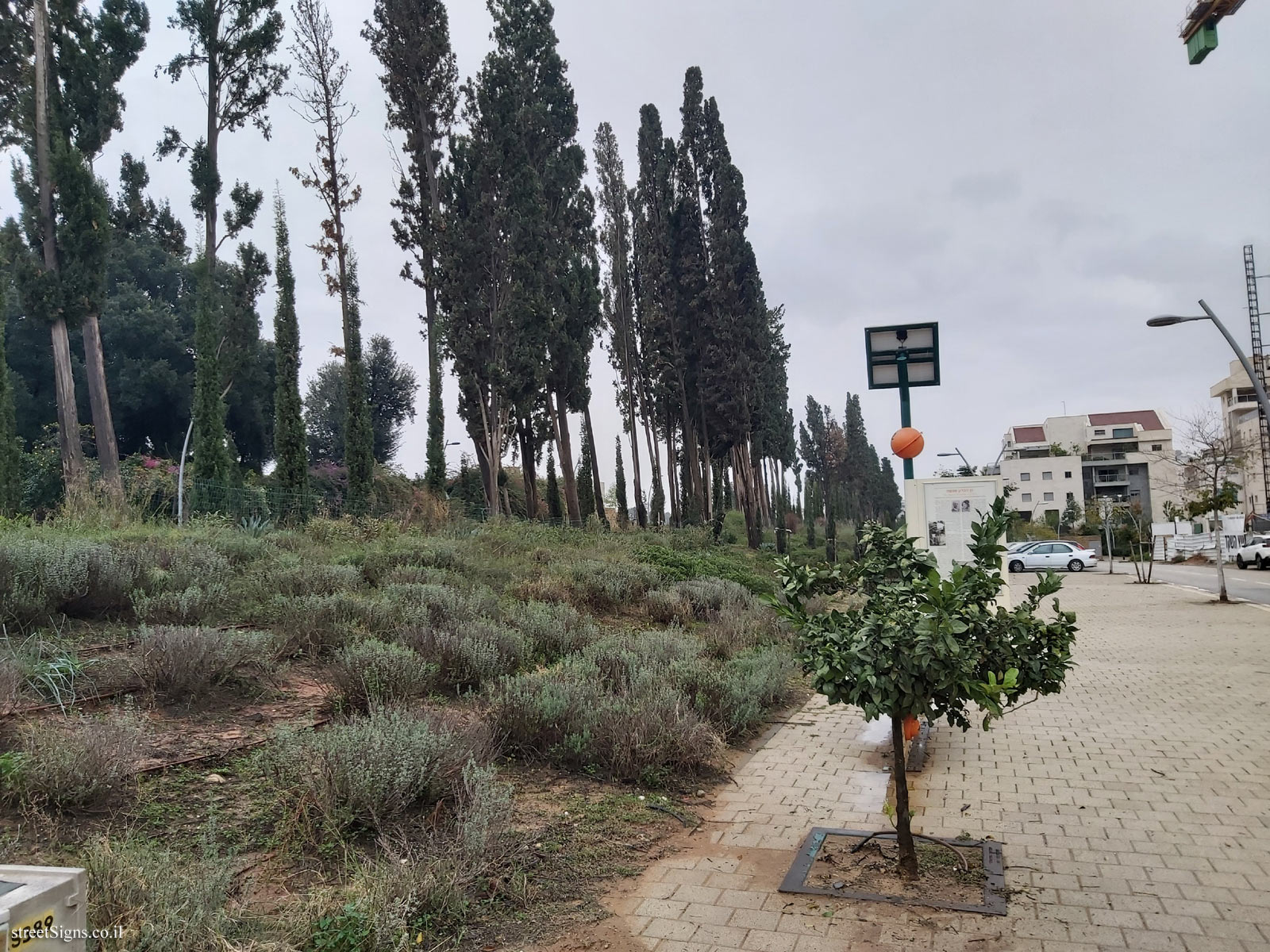On the sign:
[תמונה: תמונה וציור של הגן]
[מפת השביל]
[הצד השני של השלט]
גן הברון מנשה
The Baron Menashe Garden
במהלך שנות השלושים עברה המושבה כפר-סבא תהליך התפתחות מואץ ומהותי. בראש הפירמידה הכלכלית ניצב בכל אותן שנים ענף ההדרים. מבין המשקיעים מארצות חוץ אשר רכש קרקעות ונטע פרדסים היה הברון פליקס דה מנשה, ראש הקהילה היהודית באלכסנדריה, מהמשפחות העשירות והבולטות בעשייה למען הקהילה במקום ולמען אינטרסים מדיניים וכלכליים בארץ ישראל. בתקופה שבין שתי מלחמות העולם 1914-1943 נוצר קשר הדוק בין הברון לבין ד"ר חיים ויצמן, שהזמינו להשקיע בארץ ישראל וגם ניצל את קשריו העסקיים של הברון עם המנהיגות הערבית במצרים וירדן לקדם אינטרסים בארץ ישראל. בתקופה זו (1934) רכש הברון 200 דונם מצפון לכפר סבא עליהם נטע פרדס, ושם החל בהקמת גנו ותכנן לבנות לו בית בניצוחו של האדריכל זאב רכטר, בו יוכלו להתארח בביקוריהם הקצרים בארץ ישראל.
משנת 1939, גם אם הגן נותר בבעלות משפחת דה מנשה, הרי מעתה הוא נקשר במשפחת יופה, חיים ומרים שהוזמנו על ידי הברון להתגורר בגן ולטפחו.
על מלאכת תכנון הגן ניצח אדריכל הנוף יצחק קוטנר, אשר זה עתה עלה ארצה משוויץ ולעוזרו נתמנה ליפא יהלום, שזה עתה החל דרכו כמתכנן גנים.
למרים שהייתה הגננית העיקרית בגן, היו קשרים עם גננים ושתלנים רבים מכל הארץ, אשר הביאו לה צמחים מהארץ ואף מארצות אחרות כגון איטליה ומצרים. גן מנשה היה למקום מפגש של חברי הפלמ"ח וההגנה. בגג הבית היה סליק, ועל הגג - תחנת קשר שהוסוותה בשובך של יונים.
לגן המופלא הגיעו רבים ממנהיגי היישוב, כגון בן-גוריון וארתור רופין, אנשי תרבות כמסקין ורובינא, ואף אורחים מחו"ל כמו השחקנית האיטלקייה סופיה לורן.
During the thirties the Kfar Saba colony underwent accelerated development, and at the top of the economic pyramid throughout those same years was the citrus fruit industry. Amongst the investors from overseas who purchased lands and planted citrus orchards was the Baron Felix de Menashe. De Menashe was the head of the Jewish community in Alexandria, one of the richest and most prominent families in its work for the community there and for political and economic interests in the Land of Israel. During the period between the two world wars, 1914-1943, a close relationship developed between the Baron and Dr Chaim Weizmann, who called for investments in the Land of Israel, and also utilized the Baron’s business contacts with the Arab leadership in Egypt and Jordan to promote interests in the Land of Israel. In this period (1934) the Baron purchased 200 dunams north of Kfar Saba on which he planted an orchard, and there he started to construct his garden and planned to build a house in it, in which he could spend time during his short visits to the Land of Israel.
Although the garden remained in the ownership of the De Menashe family, since 1939, it was associated with the Yoffe family: Chaim and Miriam, who were invited by the Baron to live in the garden and nurture it.
The landscape architect, Yitzchak Kutner, who had recently immigrated to Israel from Switzerland, was responsible for the design of the garden. Lipa Yahalom, who had started out on his way to becoming a landscape gardener, was appointed as his assistant.
Miriam, who was the main caretaker of the garden, had contacts with many gardeners and planters throughout Israel, who brought her plants from Israel and even from other countries such as Italy and Egypt.
The Menashe Garden became the meeting place for members of Hahagana, and the Palmach. On the roof of the house was a secret hiding place for arms, and a communications station which was camouflaged as a dovecote. Many of the leaders of the Yişhuv came to Visit the wonderful garden such as Ben Gurion and Arthur Rupin, cultural figures such as Meskin and Rubina, and even guests from overseas such as the Italian actress Sophia Loren. Nissim Aloni’s 1966 play "The Bride and the Butterfly Hunter" was filmed there.
סמל העיר כפר סבא
סמל מוזיאון כפר סבא
שביל הראשונים על שם מרדכי שרייבמן
המוזיאון הארכיאולוגי כפר-סבא
ירושלים 35 כפר-סבא
טלפון 09.7640867
THE ARCHAEOLOGICAL MUSEUM OF KFAR-SABA
www.kfar-saba-museum.org

 Click for a larger image
Click for a larger image  Click for a larger image
Click for a larger image  Click for a larger image
Click for a larger image  Click for sign's details
Click for sign's details